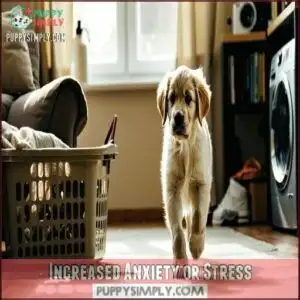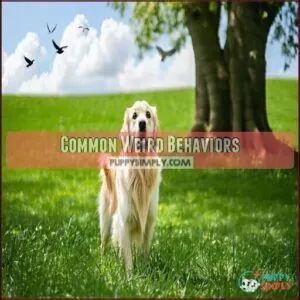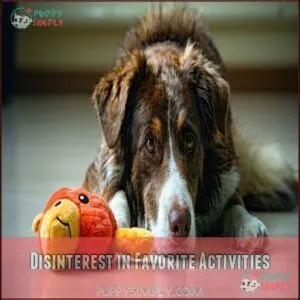This site is supported by our readers. We may earn a commission, at no cost to you, if you purchase through links.
 If your dog’s acting weird, it might mean they’re feeling off or trying to tell you something.
If your dog’s acting weird, it might mean they’re feeling off or trying to tell you something.
Changes like refusing food, pacing, or snapping at thin air can point to stress, pain, or even illness.
Sometimes, it’s as simple as an upset stomach or a noisy thunderstorm.
Other times, it could be more serious, like an ear infection, allergies, or tummy troubles.
Keep an eye out for patterns—are they skipping meals or rubbing their butt on the floor?
When in doubt, trust your gut and check with the vet.
Your pup’s quirks might just hold the key to their health!
Table Of Contents
- Key Takeaways
- Dog Acting Weird Signs
- Why is My Dog Acting Weird
- Common Weird Behaviors
- Identifying Pain and Discomfort
- Seeking Veterinary Help
- Frequently Asked Questions (FAQs)
- Why is my dog acting weird out of nowhere?
- How can you tell if your dog is unwell?
- Why is my dog not acting like herself?
- Why is my dog acting weird and distant?
- Why is my dog hiding and acting strange?
- Why is my dog acting weird?
- Why is my dog behaving weirdly?
- Why is my dog acting crazy?
- When should I be concerned about my dog acting weird?
- Why is my dog acting weird all of a sudden at night?
- Conclusion
Key Takeaways
- Watch for changes in appetite, energy, or bathroom habits, as these could signal stress, illness, or pain needing attention.
- Dogs might act weird due to stress from environmental changes, boredom, or aging-related cognitive issues.
- Unusual behaviors like scooting, shivering, or growling often point to physical discomfort or health problems.
- If odd behaviors persist or worsen after 24 hours, consult a vet to ensure your dog’s well-being.
Dog Acting Weird Signs
When your dog starts acting out of the ordinary, it’s easy to feel worried or unsure about what’s going on.
Watching for changes like unusual eating habits, odd sounds, or restless behavior can help you figure out if something’s wrong.
Changes in Appetite
A sudden loss of appetite in your dog can be alarming and might hint at underlying issues.
Whether it’s food aversion or dietary problems, it’s vital to monitor changes carefully.
- Refusal to eat favorite meals
- Leaving food bowls untouched
- Markedly reduced appetite
- Food sniffing but not eating
- Refusing walks alongside eating changes
These shifts could signal nutrition deficits needing attention, which may indicate underlying issues or dietary problems, and thus require careful monitoring to identify the cause of reduced appetite.
Unusual Vocalizations
Unusual vocalizations, like excessive barking or persistent whining, can signal emotional distress or discomfort.
Dog barking or howling may indicate anxiety, while growling sounds often suggest fear or pain.
Yipping behaviors could be playful—or a cry for help.
Pay attention to barking patterns and whining causes, as these dog anxiety symptoms might highlight problems needing swift care or evaluation.
If your dog has recently been swimming, recognizing signs of water intoxication risks is vital to provide timely intervention.
Altered Sleep Patterns
Changes in sleep patterns, like restlessness or insomnia, can signal issues.
If your dog is acting weird, pacing at night, or showing fatigue during the day, this could be a sleep disorder. Nocturnal activity isn’t normal if your dog is usually a sound sleeper.
Watch for lethargy or your dog refusing to walk. Consult your vet for guidance.
Changes in Elimination Habits
Dog accidents can be a red flag for deeper issues. Watch for stool changes, urine marking, or odd litter box habits that indicate health problems. Check for:
- Changes in urine appearance or frequency- Signs of house soiling after training- Your dog not drinking water properly- Difficulty eliminating- Persistent house soiling despite routineIt’s time to investigate!
Increased Anxiety or Stress
Dogs often show anxiety signs like pacing, panting, or hiding.
Stress triggers—like loud noises, new environments, or a change in routine—can spark a stress response in your dog.
Calming techniques such as consistent routines or soothing music can help.
If stress reduction doesn’t improve their behavior, seek professional help to address underlying dog anxiety symptoms.
Recognizing stress in dogs is essential for providing appropriate care and support.
| Anxiety Signs | Stress Triggers | Calming Techniques | Professional Help Needed |
|---|---|---|---|
| Pacing | Loud Noises | Routine Consistency | Persistent Anxiety |
| Whining | New Environments | Soothing Music | Severe Behavior Changes |
| Hiding/Cowering | Routine Changes | Safe Space/Crate | Consult Behaviorist |
| Excessive Barking | Crowds/Unknown People | Short Walks Indoors | Vet Diagnosis |
Why is My Dog Acting Weird
Many factors can explain why your pup suddenly starts acting weird.
Sudden weird behavior in dogs often signals stress, discomfort, or health issues that require your attention and care.
Environmental changes like moving to a new home, welcoming a baby, or altering your work schedule can trigger dog whining or unusual behaviors.
Health issues often manifest as strange actions—your furry friend can’t tell you directly when something hurts.
Watch for signs of pet anxiety like pacing, panting, or destructive chewing.
Aging dogs may develop cognitive issues similar to dementia, causing dog behavior changes including confusion or forgetting training.
Sometimes canine fear emerges from past trauma that you might be unaware of.
Your dog acting different could stem from boredom or insufficient mental stimulation.
Pet stress might appear after losing another household pet or family member.
If dog shivering or other strange behavior persists, consult your vet to rule out medical causes.
Understanding common dog issues can help you identify the root cause of your dog’s weird behavior.
Common Weird Behaviors
You’ll notice your dog sometimes acts in ways that seem strange.
These behaviors often have simple explanations. From spinning in circles to eating grass, these common weird behaviors can signal anything from normal canine instincts to potential health issues that need attention.
Anxiety or Stress
After identifying unusual behaviors in your furry friend, it’s important to recognize stress signs. Your dog may show anxiety through pacing, shaking, excessive yawning, or drooling.
Other canine behavior indicators include lip-licking, changes in body posture, unusual shedding, and panting. Environmental changes or disrupted routines often trigger these responses.
Try stress reduction techniques like maintaining consistent schedules and providing safe spaces. Simple anxiety management approaches can help your dog feel secure.
Utilizing dog anxiety tools, such as those found in anxiety relief products, can be beneficial in reducing anxiety and helping your dog.
GI Upset
Your dog’s sudden GI upset can transform a normal day into a mess.
When you notice vomiting, diarrhea, or decreased appetite, your pup might be dealing with food poisoning, dietary indiscretion, or intestinal parasites.
Stress and sudden food changes can also trigger stomach issues.
Most mild gut health problems resolve within 24 hours, but persistent symptoms warrant a vet visit to rule out serious conditions and ensure the overall gut health of your pet.
Impacted Anal Glands
Scooting across your floor might signal your dog has impacted anal glands.
These small sacs can become clogged, causing rectal discomfort and butt rubbing behaviors.
You’ll notice your pup dragging their rear, licking excessively at their hindquarters, or showing signs of pain when sitting.
Anal sac problems need veterinary attention – they won’t resolve on their own and can lead to infection if untreated.
Allergies
Your furry friend’s sudden itching crusade could signal allergies at work.
Dogs with allergies often scratch constantly, develop skin infections, or seem uncomfortable in their own fur.
Food allergens, flea bites, and environmental triggers can cause allergic reactions ranging from itchy ears to anal gland problems.
Watch for excessive licking, red skin, or hair loss – these are classic signs your dog’s immune system is overreacting.
Identifying food allergy symptoms is essential to determining the best course of action for your pet’s specific needs to address skin infections.
Ear Infections
Through constant head shaking and ear scratching, your dog may be signaling an ear infection.
You’ll notice ear odor, redness, or dark discharge.
Dogs with ear infections often tilt their heads or show balance issues.
Some may experience hearing loss or seem irritable when touched near the ears.
Veterinarians diagnose using ear cytology and can prescribe appropriate treatments for this common dog health concern.
Identifying Pain and Discomfort
Your dog can’t tell you when they’re hurting, but their behavior speaks volumes about their physical state.
Pay attention to your dog’s actions—they’re the silent language that reveals their pain and what they need.
You’ll need to watch for subtle signs like reluctance to move, unusual aggression, or changes in routine activities that might indicate your furry friend is experiencing pain or discomfort.
Lying Around or Refusing to Get Up
Lethargy speaks volumes when your normally active companion suddenly refuses to get up.
If your dog is lying around more than usual, pay attention to these potential causes:
- Pain from joint issues or medical conditions, especially common in older dogs
- Age factors that reduce mobility and energy levels
- Medication side effects causing temporary reluctance to move
Watch for accompanying signs like refusal to eat or walk, which often indicate discomfort requiring veterinary attention.
Growling or Snapping
When your normally friendly dog suddenly growls or snaps when approached, it often signals pain rather than aggression.
Your dog isn’t being "bad" – they’re communicating discomfort.
| Pain Triggers | Fear Responses | Defensive Behavior |
|---|---|---|
| Joint pain | Ears back | Growling |
| Ear infections | Whale eye | Snapping |
| Dental issues | Lip licking | Bite injuries |
Don’t punish dog aggression – instead, see your vet to address potential underlying health issues causing this protective reaction.
Rubbing Their Butt on The Floor
Scooting across your floor isn’t your dog’s attempt at a new trick.
This butt rubbing behavior typically signals anal gland issues that need attention.
When these small glands become impacted, your dog uses floor friction for relief.
You’ll notice them dragging their rear end repeatedly.
Don’t ignore this sign of discomfort—it rarely resolves without intervention and could indicate infection or inflammation requiring veterinary care.
Disinterest in Favorite Activities
When your playful pup suddenly ignores their favorite squeaky toy or turns down a game of fetch, it’s a red flag. Dog disinterest in activities they once loved often signals pain or illness.
Watch for dog lethargy, dog hiding, or dog refusal to walk. Loss of interest might stem from joint pain, depression, or simply boredom factors.
Try offering new mental stimulation, but if decreased play persists, consult your vet. Addressing dog pain relief options, such as those related to dog pain management, can help identify underlying causes.
Changes in Eating Habits
When your dog suddenly changes their eating habits, it’s often a red flag.
Food refusal or complete loss of appetite can signal pain or illness.
Your previously enthusiastic eater becoming a picky eater deserves attention.
Likewise, a dog that develops an eating frenzy or starts overeating might be experiencing health issues.
If your dog is whining near their food bowl or showing lethargy with refusing to eat, call your vet.
Seeking Veterinary Help
You’ll need to call your vet when your dog’s weird behavior doesn’t improve or gets worse.
Prompt veterinary care can identify hidden health issues and provide the treatment your dog needs to feel better.
Persistent or Severe Symptoms
When your dog’s weird behavior persists for more than 24 hours, it’s time to call the vet.
Severe whining, excessive panting, compulsive spinning, or sudden aggression aren’t just quirky habits—they’re often warning signs of serious health concerns.
Neurological issues can cause a dog sudden behavior change that requires immediate attention.
Don’t wait until your pet’s condition worsens; these dog illness signs need professional evaluation.
Changes in Appetite or Water Intake
When your pup’s eating habits or water consumption suddenly changes, it’s time to call the vet.
Changes in appetite or water intake often signal underlying health issues that need professional attention.
Monitoring your dog’s water intake habits is essential for early detection of potential health problems.
Here are five warning signs to watch for:
- Complete food refusal for over 24 hours
- Excessive thirst (drinking more than usual)
- Dramatic decrease in water intake
- Sudden pickiness with food preferences
- Noticeable weight loss despite normal eating
Vomiting or Diarrhea
Vomiting or diarrhea can make you wonder, "Why is my dog acting strange?"
These symptoms often point to stomach issues like food poisoning, digestive problems, or dog GI upset.
Keep an eye on their gut health and bowel movements.
Chronic or severe cases signal serious dog health concerns, so don’t hesitate to call the vet for guidance.
Medical Exams and Tests
A physical exam is often step one for addressing dog health concerns.
Your vet may recommend blood tests, urinalysis, or X-rays to spot hidden issues. Ultrasound and biopsy can dig deeper into mysteries like unexplained lumps.
These dog diagnostics are essential for pinpointing problems quickly. Trust the veterinarian’s expertise—your pup’s health depends on these thorough checks!
Regular dog health tests, including dog health assessments, are imperative for maintaining your dog’s overall well-being.
Behavioral Assessments
Sometimes, strange behavior stems from misunderstood canine body language or dog stress signs.
A vet may recommend a behavioral assessment to rule out dog behavioral issues or check your pet’s mental health.
Experts use animal learning theory and dog socialization techniques during these evaluations.
With proper behavioral modification, odd habits or dog behavior problems often improve, restoring balance and happiness.
Frequently Asked Questions (FAQs)
Why is my dog acting weird out of nowhere?
Your dog’s sudden weird behavior might signal illness, pain, stress, or environmental changes.
Look for symptoms like appetite loss, shivering, or discomfort.
If it persists, consult your vet—it’s better to play it safe.
How can you tell if your dog is unwell?
Watch for changes in appetite, energy, or bathroom habits.
Unusual behaviors like shivering, whining, or hiding can signal illness.
If your dog seems off, trust your gut and consult a vet—better safe than sorry!
Why is my dog not acting like herself?
When your pup seems off, it’s like their spark dimmed a little.
Changes in behavior could mean stress, illness, or discomfort.
Look for clues like appetite shifts or unusual habits, and call your vet.
Why is my dog acting weird and distant?
Your dog’s distant behavior could signal stress, illness, or changes in their environment.
Look for shifts in appetite, energy, or bathroom habits.
When in doubt, a vet visit helps rule out health concerns.
Why is my dog hiding and acting strange?
Imagine this: your dog curled up in a shadowy corner, avoiding attention.
They might feel anxious, scared, or unwell. Changes in environment, pain, or stress often cause such behavior.
A gentle vet check helps to identify the issue, and anxious behavior can be addressed with proper care.
Why is my dog acting weird?
Your dog’s odd behavior could mean stress, illness, or anxiety.
Changes in their routine, health issues, or environmental shifts might be causing it.
If it continues, check with a vet to pinpoint the cause.
Why is my dog behaving weirdly?
Strange behavior in dogs often points to stress, illness, or boredom.
Changes in routine, diet, or environment could be the culprit.
Keep an eye on symptoms, and if it continues, consult your vet.
Why is my dog acting crazy?
Did you know 67% of unusual dog behavior stems from stress or boredom?
If your dog’s acting crazy, it could be pent-up energy, anxiety, or even a health issue.
A vet consult is wise!
When should I be concerned about my dog acting weird?
You should worry if your dog’s odd behavior includes appetite loss, shaking, whining, or new aggression.
Sudden changes might signal pain, illness, or stress.
Trust your gut—consult a vet if things feel off.
Why is my dog acting weird all of a sudden at night?
Your dog’s sudden weird behavior at night could mean fear, anxiety, pain, or health issues.
Loud noises, unfamiliar changes, or discomfort might disrupt their routine.
Watch for signs and consider asking your vet for help.
Conclusion
Your dog’s odd behavior can feel like piecing together a puzzling mystery.
If you’re wondering, “why is my dog acting weird,” watch for signs like appetite changes, vocalizing, or unusual habits.
These could point to stress, pain, or illness, and trust your instincts—mild issues might resolve, but serious or lasting symptoms need a vet’s help.
A little vigilance can make a world of difference, keeping your pup wagging, happy, and healthy for the adventures ahead.
- https://www.rover.com/blog/dog-acting-weird/
- https://www.pethonesty.com/blogs/blog/10-signs-your-dog-is-acting-weird-what-to-do-next
- https://harlingenveterinaryclinic.com/blog/why-is-my-dog-shaking-and-acting-weird-all-of-a-sudden/
- https://www.sparkpaws.com/blogs/community/dog-acting-weird
- https://creeksidepetcare.com/blog/what-to-do-if-your-dog-is-shaking-and-acting-weird-all-of-a-sudden/


















